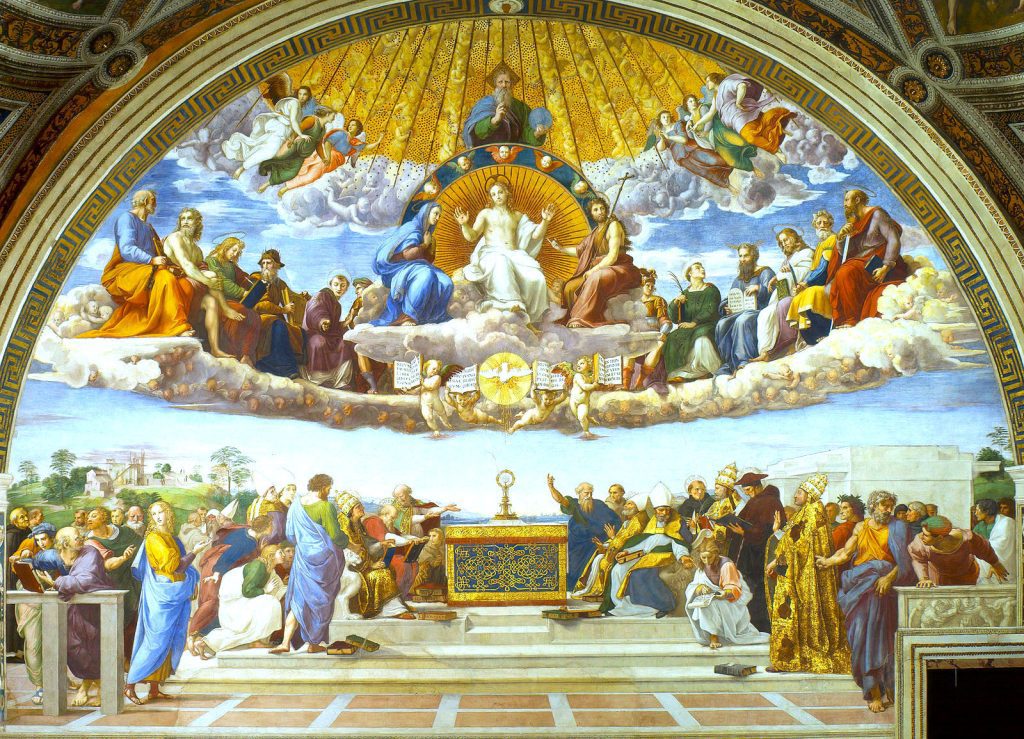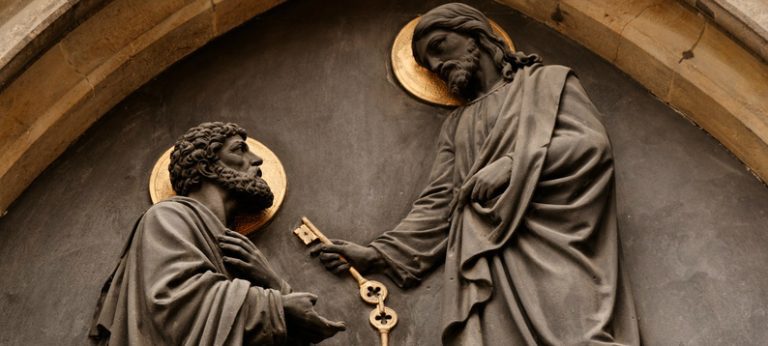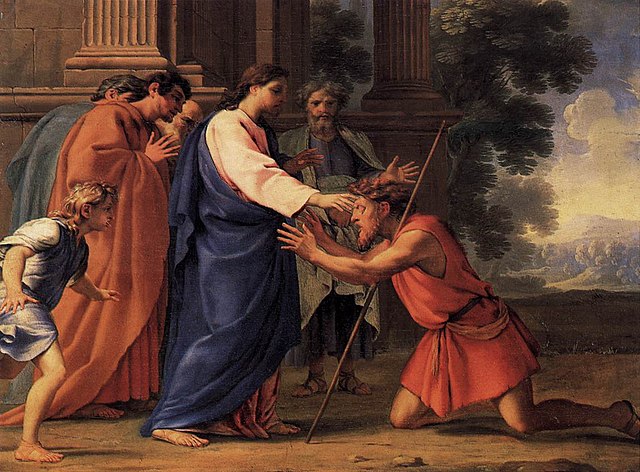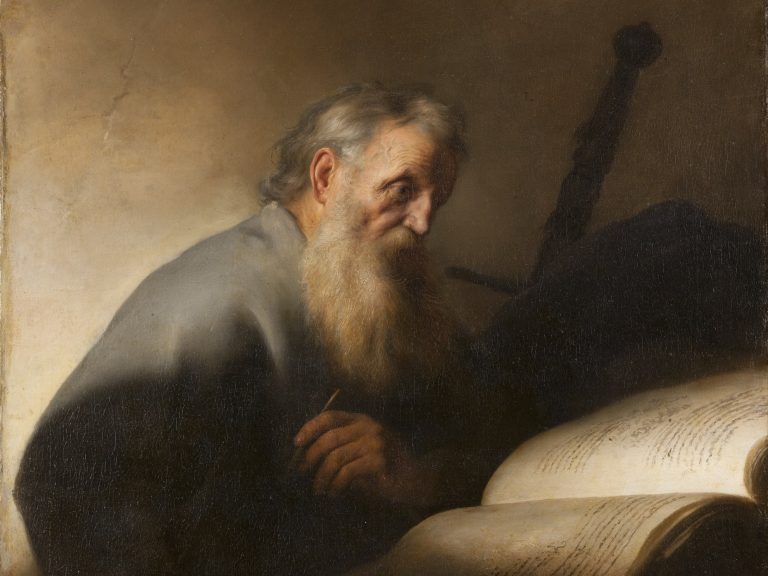John, Chapter 21: 1. “After this, Jesus revealed himself again to his disciples at the Sea of Tiberias. . . . Jesus said to them, “Children, have you caught anything to eat?” They answered him, “No.” So he said to them, “Cast the net over the right side of the boat and you will find something.” So they cast it, and were not able to pull it in because of the number of fish.”
(Is Jesus telling the ages that converts are to be found on the right, not on the left? Catholic Fundamentalists infer from this that He thinks it is a waste of time to try to convert liberals, whom He arranged to have sitting on the left in the governing body of the French Revolution.)
21:4 “When they climbed out on shore, they saw a charcoal fire with fish on it and bread.”
(Where did the charcoal come from? Charcoal, made of ‘baked wood’, was expensive. Charcoal burns hotter than wood, signifying the purification and transformation of raw ore into desired metals like steel. Without charcoal, the making of which was a trade secret, there would have been no steel. Charcoal was as great a technological step forward in the Iron Age as the computer in our own time, yet it appeared on an isolated beach.)
21: 10 “Bring some of the fish you just caught.” (Why were 153 fish in the net? What is the significance of the 153 fish? Some of the fascinating properties of number 153 are:
153 is the smallest number which can be expressed as the sum of cubes of its digits: 153 = 13 + 53 + 33
153 is equal to the sum of factorials of number from 1 to 5: 153 = 1! + 2! + 3! + 4! + 5!
The sum of digits of 153 is a perfect square: 1 + 5 + 3 = 9 The square root of 9 is three, bringing us to The Trinity.
The sum of aliquot divisors of 153 is also a perfect square: 1 + 3 + 9 + 17 + 51 = 81 = 92
Aliquot divisors of a number are all the divisors of that number excluding the number itself but including 1. It is seen that the sum of aliquot divisors of 153 is the square of the sum of the digits of 153.
On adding the number 153 to its reverse,504 is obtained. That square is the smallest square which can be expressed as the product of two different numbers which are reverse of one another: 153 + 351 = 504.
It can be expressed as the sum of all integers from 1 to 17. In other words, 153 is the 17th triangular number. Since reverse of 153, i.e. 351 is also a triangular number, 153 can be termed as a reversible triangular number.
Number 153 is also a Harshad number(also called Niven number), i.e. it is divisible by the sum of its own digits: 153 / (1 + 5 + 3) = 17 Since reverse of 153, i.e. 351, is also a Harshad number(or Niven Number), 153 can be termed as a reversible Harshad number(or reversible Niven Number).
It can be expressed as the product of two numbers formed from its own digits: 153 = 3 * 51
Note that the digits used in multipliers are same as in product.
The number 135, which is formed by rearranging the digits of 153, can be expressed as: 135 = 11 + 32 + 53
The sum of all divisors of 153 is 234. 1 + 3 + 9 + 17 + 51 + 153 = 234 The product of all divisors of 153 is 23409. 1 * 3 * 9 * 17 * 51 * 153 = 23409
Note that the product of aliquot divisors of 153 contain the sum of all divisors of 153 juxtaposed: 23409 = 234:09 234 = Sum of all divisors of 153
09 = Square root of the sum of aliquot divisors of 153.
When the cubes of the digits of any number, that is, a multiple of 3 are added, and then this process is repeated, the final result is 153, where the process ends because 153 = 13 + 53 + 33
For example: Take the number 108. 13 + 03 + 83 = 513 and 53 + 13 + 33 = 153 So, the number 108 reaches 153 in two cycles and it can be represented as
108®513®153
A detailed study of all numbers up to 105reveals that all numbers which are multiple of 3 and are less than 105 reach 153 (after the repeated process of summing the cubes of digits is done) in maximum 14 cycles. However, maximum 13 cycles is required for all numbers, which are multiple of 3 and are less than 10,000.
The smallest number, which requires 13 cycles to reach 153, is 177, i.e., 177® 687® 1071®345® 216® 225® 141® 66® 432® 99® 1458® 702® 351® 153.
Other observations on number 153: The smallest number to reach 153 in 16 cycles will be more than 1061042524005486968, so not advisable to try it. But you can certainly try to find the smallest number reaching 153 in 15 cycles and check your answer by clicking here.
If all 6 combinations of number 1, 5, 3 are taken to form a three digit number then the following holds good: 153 + 315 + 531 = 351 + 135 + 513
10 + 51 + 32 = 1 * 5 * 3
If p(x) represents the number of primes up to x, then the following holds good: p (153) = p (15) * 3!
10 + 51 + 32 = 15 11 + 52 + 33 = 53
153153 is the smallest odd abundant number ending in 3. 153153, 351351, 513513 are all odd abundant numbers.
One book of sacred writings is titled The Hidden Words. It is a collection of short meditations, divided into two sections. The first section contains 71 items that were revealed in Arabic; the second section of 82 items was revealed in Persian (Farsi). I think you see my point already….. 71 + 82 = 153. I have often told my fellow believers about this connection between math and our Faith’s literature. They are always quite impressed, to say the least.(Sent by a reader many years ago.)
Let us say 153 increasingly from left to right:1, 15, 153 We find that 115153 is prime.
One hundred (and) fifty-three is the natural number following one hundred (and) fifty-two and preceding one hundred (and) fifty-four. As a triangular number, it is the sum of the first 17 integers, and also the sum of the first five factorials. It is also a hexagonal number.
The distinct prime factors of 153 add up to 20, and so do the ones of 154, hence the two form a Ruth-Aaron pair.
Another interesting feature of the number 153 is that it’s the limit of the following algorithm:
Take a random number, divisible by three. Split that number into its base 10 digits. Take the sum of their cubes. Go to the second step.
An example, starting with the number 84:
83 + 43 = 512 + 64 = 576
53 + 73 + 63 = 125 + 343 + 216 = 684
63 + 83 + 43 = 216 + 512 + 64 = 792
73 + 93 + 23 = 343 + 729 + 8 = 1080
13 + 03 + 83 + 03 = 1 + 0 + 512 + 0 = 513
53 + 13 + 33 = 125 + 1 + 27 = 153
13 + 53 + 33 = 1 + 125 + 27 = 153
Evagrius Ponticus considered 153 to represent a harmonization of contrasts, since 153 = 100 + 28 + 25, with 100 representing a square, 28 a triangle and 25 a circle.
Since 153 = 13 + 53 + 33, it is a 3-narcissistic number, and it is a Friedman number since 153 = 3 * 51. It is a Harshad number in base 10.
When we study just a few examinations of 153, we find so much significance that we hardly know where to begin, but we do see some of the significance that He Who programmed the very system of numbers would understand perfectly. If you and I keep an eye out for 153, we’ll see more meaning as we go through life.
And, what of the ‘large fish’? Were they five pounds each? Even at two or three pounds each, they would be a huge weight for one man to drag up and out of the water. Was Peter stronger than a gladiator? Was he given superhuman strength of bone, joint, and muscle by the God He loved?
Even though the load was so heavy, the net was not torn. What was the net made of? How was it kept from ripping while being dragged up and across the rough beach? Was Jesus continually “programming” it to be repaired as it was torn, as He repairs The Church as it moves through time, drawing souls to God across the shoals of temptation? As our parish priests repair our souls at Confession?
Jesus said to them, “Come, have breakfast.” And none of the disciples dared to ask him, “Who are you?” (What kind of a being are you, who would rise from the dead, appear here to have breakfast with us, tell us where to fish, arrange for us to catch exactly 153 of them, and keep our net from ripping?)
because they realized it was the Lord. 13 Jesus came over and took the bread and gave it to them, and in like manner the fish. (He did not use the fish they’d caught, but gave them the fish he had alaready cooked over the charcoal.) This was now the third time Jesus was revealed to His disciples after being raised from the dead.
In conclusion: in 1 Rosary, there are 53 Hail Mary’s. Again, the # 153 appears!









